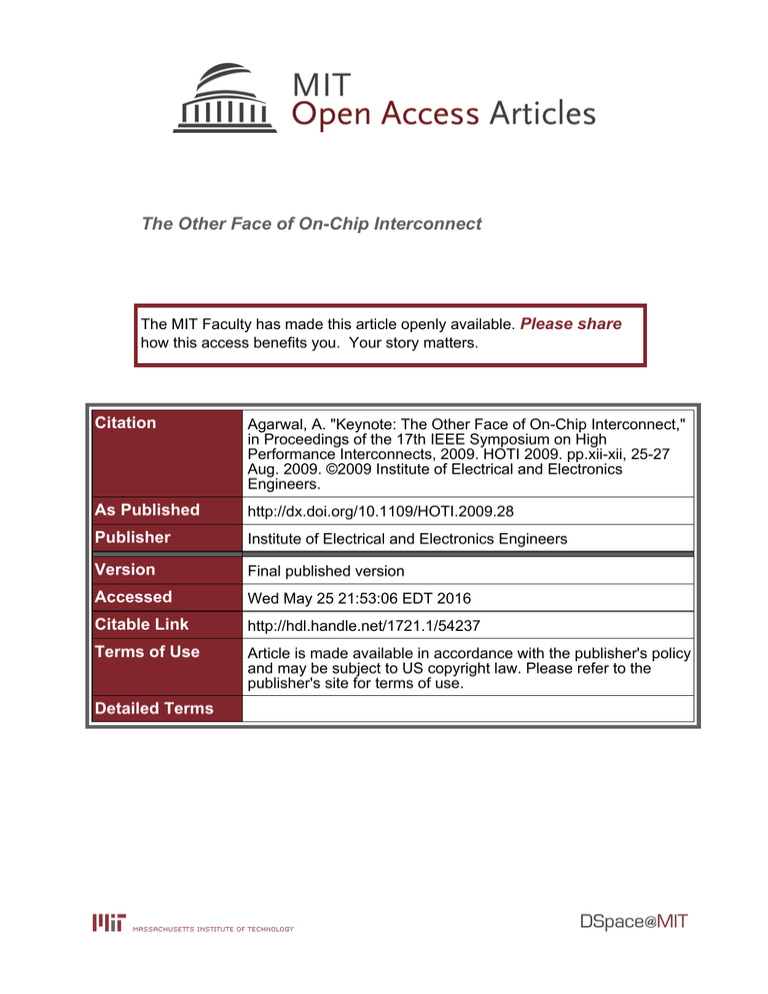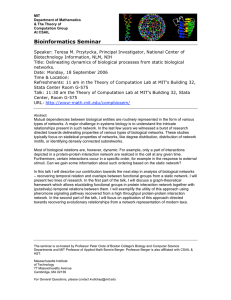The Other Face of On-Chip Interconnect Please share
advertisement

The Other Face of On-Chip Interconnect The MIT Faculty has made this article openly available. Please share how this access benefits you. Your story matters. Citation Agarwal, A. "Keynote: The Other Face of On-Chip Interconnect," in Proceedings of the 17th IEEE Symposium on High Performance Interconnects, 2009. HOTI 2009. pp.xii-xii, 25-27 Aug. 2009. ©2009 Institute of Electrical and Electronics Engineers. As Published http://dx.doi.org/10.1109/HOTI.2009.28 Publisher Institute of Electrical and Electronics Engineers Version Final published version Accessed Wed May 25 21:53:06 EDT 2016 Citable Link http://hdl.handle.net/1721.1/54237 Terms of Use Article is made available in accordance with the publisher's policy and may be subject to US copyright law. Please refer to the publisher's site for terms of use. Detailed Terms Keynote 1 Title: The Other Face of On-Chip Interconnect Speaker: Anant Agarwal, CSAIL, MIT Abstract: The multicore revolution has changed the way we think about computing. The same movement has also changed the way we look at on-chip interconnect because it is a key determinant of the performance and power efficiency of multicores. This talk will highlight some of the lesser known issues and opportunities of on-chip interconnect, such as protection, programming ease, and the impact on the basic structure of our software. The talk will borrow heavily from our experiences with on-chip interconnect in university research with the 16-core Raw multicore processor, in a commercial environment with Tilera's 64-core Tile processor, and in a future 1K-core multicore processor called ATAC that integrates optical and electrical interconnects. Bio: Anant Agarwal is the Co-Founder and Chief Technology Officer of Tilera Corporation, a professor of Electrical Engineering & Computer Science at MIT, and a member of the CSAIL Laboratory. His teaching and research interests include computer architecture, VLSI, compilation, and software systems. Dr. Agarwal served as Associate Director of the MIT Laboratory for Computer Science (LCS) between 1998 and 2003, and is a co-leader of the Oxygen Project. He led a group that developed Sparcle (1992), an early multithreaded microprocessor based on the SPARC architecture, and the Alewife machine, a scalable shared-memory multiprocessor (1993). At MIT's CSAIL laboratory, Dr. Agarwal led the Raw project which developed a tiled multicore microprocessor for instruction level parallelism (ILP) and streams (2002). Anant also led the VirtualWires project at MIT. He has been a founder of several successful start-ups, including Virtual Machine Works, Inc. (1993). Dr. Agarwal won the Maurice Wilkes prize for computer architecture in 2001, the Presidential Young Investigator award in 1991, and the Louis D. Smullin Award for teaching excellence at MIT in 2005. Dr. Agarwal holds a Bachelor Degree from IIT Madras and a Ph.D. in Electrical Engineering from Stanford University. xii Authorized licensed use limited to: MIT Libraries. Downloaded on April 05,2010 at 13:09:03 EDT from IEEE Xplore. Restrictions apply.





